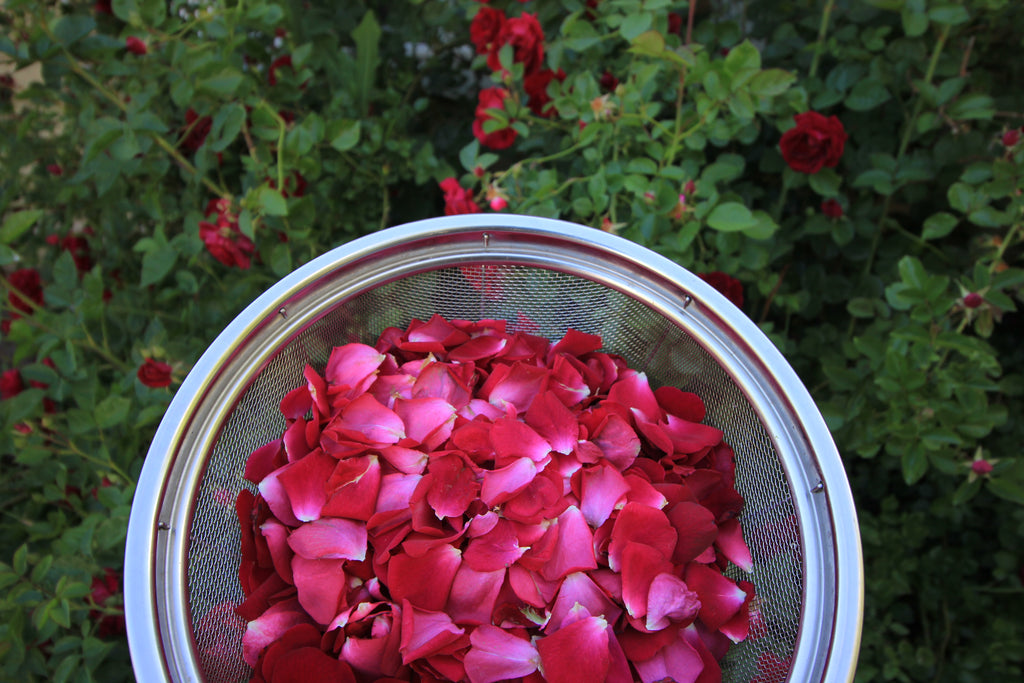Written by Elliott Brinkley, Clinical Herbalist & Owner of Dancing Willow Herbs
Of the many interesting topics in the wellness sphere, few things make me feel as passionate as hormonal health and female empowerment. Growing up in a society that shames menstruation, and fails to teach the basics of female reproductive cycles, I remember feeling confused, helpless and afraid when it came to my hormones. The option presented to me by mainstream doctors when it came to menstrual cramps, acne, and hormonal fluctuations was the birth control pill.
They nonchalantly handed me a box of blue pills that I took without asking questions like, “Why are my hormones out of balance in the first place?” “Maybe there is something deeper at play with my menstrual cramps?” “What are the side effects of this medication?”.
After a few emotionally tumultuous years on birth control, I came across the fertility awareness method of charting ones cycle. It was then, at 20 years old, that I learned that there were 4 phases of the menstrual cycle. This felt like a spark of knowledge that lit my fires of passion. I am immensely grateful that I found this information, because many women never have the privilege to learn the literacy of their bodies. But at the same time, I was enraged that I wasn’t taught this when I first started menstruating.
Menstruating doesn’t have to be a curse. It can be something that is celebrated, revered, honored as sacred.
This information gave me permission to lean into my cyclical nature- the nature that is suppressed in our production driven culture. A cycle characteristic of moments of expansion, balanced by periods of rest.
You deserve access to this knowledge, the knowledge of how your body works and the ways that you can lean into its innate gravitations.
In this blog post, I break down the anatomy/physiology of the 4 phases of the menstrual cycle and provide ways that you can support each phase with lifestyle, diet, and herbs to become more aligned with your inner lunar cycle.
The Menstrual Cycle
The menstrual cycle refers to the entire monthly hormonal/reproductive cycle. The average normal cycle is 28 days but individuals can have a normal/regular/healthy cycle that spans anywhere from 21-40 days. Within the window of the menstrual cycle, there are 4 phases that occur under the rein of hormonal influence, and physiological changes. The 4 phases are distinguished as follicular, ovulatory, luteal and menses. Everyone experiences these cycles within their bodies differently and at various lengths. The “days” are a general average outline, by tuning into your own unique rhythm you may find that you ovulate earlier or later than the average and that may be completely normal and healthy for you.

Follicular
Spring, Maiden, Growth
The follicular phase begins once the hormones start to increase again after their drop during menstruation. This usually occurs from Day 2 to 4 of your menstrual cycle and continues until ovulation around day 14.
During the follicular phase, the ovaries are growing and egg within a follicle. In order to stimulate this growth, the anterior pituitary gland releases follicle stimulating hormone (FSH) which binds to the cells in the ovary and causes them to proliferate. While the follicle is being stimulated by FSH and growing, the ovary is also releasing large amounts of estrogen relative to progesterone.
Estrogen stimulates the growth of the endometrial lining, which begins to build again after menstruation. Estrogen also stimulates and maintains bone density and has an antidepressant effect. The dominance of estrogen, may explain why one may have higher energy levels during this phase. Estrogen will also make your basal body temperature cooler than the second half of the cycle, whom is ruled by progesterone.
In addition to all of these physiological happenings, at some point during this phase the cervix will begin to produce an alkaline mucous. The ph of the vagina is typically incredibly acidic, to kill bacteria or sperm at inopportune times of the month. During the follicular phase, the body is preparing to fertilize the egg that the ovaries are growing. Because of this, the cervical mucous alters the ph of the vagina with its watery, elastic discharge. Many will identify this fertile window by observing egg white like mucous. The cervical canal will also widen at this time, allowing entry for the sperm to travel up through the alkaline mucous.
The follicular phase is like our inner spring time. With rising levels of estrogen, we tend to be more open to new ideas, projects and social settings. Estrogen also provides us with more energy to use in higher intensity exercise. Think of the way that you feel in the spring- ready to get out, seize the day and invite the new growth to come out of the ground. You can try to cultivate this energy within you as you move through your follicular phase.
Practices for this time
- Start new projects
- More high intensity exercise
- Try new things
- Eat more fresh vibrant foods: Salads, spring rolls, lighter proteins
- Work with herbs that embody spring: Nettle, Raspberry leaf, Dandelion, Violet
- Herbs that support the body during the follicular phase: Black Cohosh, Dong Quai, Fennel and Alfalfa

Ovulatory
Summer, Mother, Pleasure
Ovulation occurs at the moment when the follicle releases the egg. Some will experience uni-lateral twinge like pains in the lower abdomen during ovulation- this is due to the egg being shot out of the ovary to be fertilized. The release is triggered by an immense spike in sex hormones- estrogen, progesterone, follicle stimulating hormone and luteinizing hormone. The cervical mucous at this time will be more watery in quality, the peak of its alkalinity. While ovulation is a moment in time, there is a doorway about 3 days before the egg is released to where the energy of this physiological event can be leaned into. Pleasure will be heightened and the surge of hormones will need to be adequately detoxified.
Practices for this time
- Lean into pleasure
- Juicy foods, your favorite most delicious foods
- Socialization
- Higher intensity exercise
- Herbs that embody summer: Rose, Elderflower, Linden, Calendula, St. John’s Wort
- Herbs that can assist with ovulation: Dandelion root, Maca, Shatavari, Ashwagandha, Licorice

Luteal
Autumn, Maga, Prepare
After ovulation, the follicle that once held the egg degrades under the influence of Luteinizing Hormone (LH) into what is called the corpus luteum. The corpus luteum is a transient endocrine organ that produces progesterone (plus a little estrogen and testosterone). The function of the corpus luteum’s release of progesterone is to set the stage in the endometrium by vascularizing the tissue so it is ready for the implantation of a fertilized egg.
During this phase, cervical mucus production decreases, thickens and will be less elastic. The cervical canal will close and the positioning of the cervix will sit lower. While estrogen has another peak at some point during the luteal phase, the dominant hormone at this time is progesterone. Progesterone tends to influence a calmer and slower pace. This is why the luteal phase is when our bodies are asking us to start to wind down. Follow an inner autumn, and prepare for your menstruation phase.
Practices for this time:
- Clean your home
- Prep nourishing meals
- Strength building exercise, walks/hikes, yoga/pilates
- Warm, cooked foods like soups, stews, cooked vegetables, high nutrient density foods like grass-fed liver
- Herbs that embody autumn: dandelion, burdock, rosehips, hawthorn, ginger, medicinal mushrooms like reishi, shiitake
- Herbs that support the luteal phase: dandelion, burdock, ginger, reishi, cramp bark, wild yam, white peony root, dong quai, raspberry leaf

Menses
Winter, Crone, Rest
Menses is a sacred window and opportunity to cultivate rest. In the absence of pregnancy, the corpus luteum stops secreting hormones. All of the sex hormones drop off significantly, which then signals the shedding of the endometrial lining. The endometrium releases prostaglandins, which are hormonal messengers signaling the inflammatory response, and causing contractions of the smooth muscle that lines the uterus. Menstrual pain is commonly caused by an overactive inflammatory response, pelvic stagnation, or nutrient deficiencies. Within two days after the beginning of bleeding, the follicles start growing and producing estrogen- so the cycle starts all over again.
Practices during this time:
- Schedule time to rest as much as possible.
- Honor your menstrual cycle by giving your blood back to the Earth (menstrual cups, soaking reusable pads or period underwear in water). There is a Hopi prophecy that states, “When the women give their blood back to the earth, men will come home from war and earth shall find peace.”
- Connect to your intuition & dreams.
- Consume easy to digest, nourishing, warm foods: bone broth, soups
- Herbs that embody winter: Elderberry, medicinal mushrooms, ginger, aromatic herbs/spices
Herbs that support menstruation:
- Our Mense Soothe tincture, purchase here!
- Pain relief: wild yam, white peony, cramp bark, valerian, wild lettuce, jamaican dogwood, pedicularis, skullcap
- Warming herbs/pelvic stagnation: ginger, cinnamon, angelica sinensis (if not heavy periods)
- Nourishing: nettle, raspberry leaf
- Anti-inflammatory: turmeric, willow bark, meadowsweet
Further learning:
Harmonious Hormones Class, November 9th at Dancing Willow Herbs
This class will be a deeper dive into the menstrual cycle and what to do if your hormones are out of balance. We will go into even more depth to discuss the anatomy of the various phases of our monthly reproductive cycle, and ways to support them. We will discuss herbal therapeutics for balancing hormones and how to address common hormonally based conditions such as PCOS, endometriosis, estrogen dominance and more. You will leave with a deeper understanding of your body and how to create harmony within your hormones.
Sign up here: Harmonious Hormones Class
I hope that this provides you with some empowerment to know that your body is complex and beautiful.
When we observe nature, we see cycles all around us. The waxing and waning of the moon, seasonal shifts, ebb and flow of tide, expansion and contraction. Our watery bodies are subject to the same spell of the moon as the ocean’s current. The call of the womb is one of cyclicality, fluidity and an ever-changing rhythm that we can decide to harmonize with. When we choose to deepen our relationship with our body’s natural cycles, we are given a monthly opportunity to experience the fullness of expansion and release in appropriate timing. Healing is not linear, neither is your body’s experience.
With love always,
Elliott

